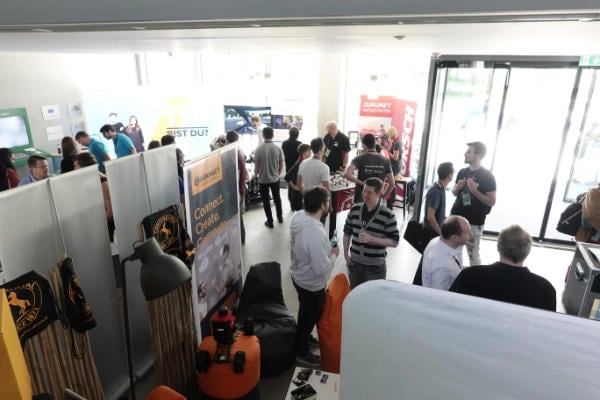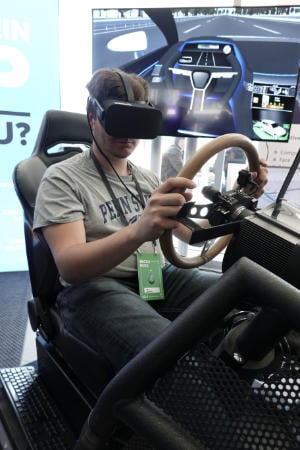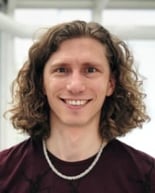
Teaming up with like-minded technology enthusiasts to try out new formats and develop innovative ideas and solutions? This is exactly what the two days (and one night) of the hackathon event 'Hackaburg' at Techbase Regensburg were all about. As one of the sponsors, knowis AG was present on site: The software developers Michael Decker and Yerlan Baiturinov supported the students with their know-how. Their colleague Ion Sirotkin, who is currently working on his master’s thesis, was in the middle of the action and reports on his experience as a hackathon participant.
On May 24 and 25, creative programmers, web designers and entrepreneurs met for the 2019 edition of Hackaburg at Techbase Regensburg. Last year, the sponsors and about 120 participants from all over Germany had already transformed the location into a technical playground over the weekend to work on a variety of projects in more than twenty teams, to network and to gain new experience. After all, even though 'hacking' might evoke negative associations, this is what it means: finding a creatively improvised solution for a programming or hardware problem.

Coffee, Coding, Making Contacts
This year’s start of Hackaburg was just as promising. The sponsors had prepared a variety of tasks for the motivated teams. Based on several tracks, i.e. different subject areas, the participants of a hackathon are challenged to apply new methods and eventually develop concrete projects within a very short time span. This time, the focus was on robotics, hardware games and data protection. Ion, who works for knowis and is currently writing his master’s thesis, tells us about his impressions as a participant of this year's event.
 Ion, this was the first time you participated in a hackathon – how did you start off the event?
Ion, this was the first time you participated in a hackathon – how did you start off the event?
After drinking the first of many cups of coffee that day, I tried to get an overview first. It was very interesting to discover the whole range of topics the companies represented. The creation of Arduino circuit boards, computer-aided cruise control for cars, application development and data hosting were just a few of the many domains the sponsors focused on.
How did the hackathon begin?
A brief introduction provided participants with the rules and helpful information for the hackathon, and we also got a voucher for free cloud hosting and domain names. The various sponsors then presented the six tracks we could work on. Right after this, the first participants went on stage to present their ideas and win team members for the joint work on their project. That's how I found my team.
What project did you work on with your team?
We had a very simple but funny idea: a game consisting of a box which the players can connect to via WLAN on their mobile phones. On the box there is a movable arrow; all cables and components needed for this are hidden inside the box. If the players are connected to the box, they receive a question relating to software development that is not meant to be taken too seriously, for example: "Who would most likely destroy the production server?” You then have to decide which player this applies to. Once everyone has voted or the time has elapsed, the arrow spins to indicate who received the most votes.
I really liked the concept of establishing a connection between a physical device and a smartphone. I've worked on similar projects, such as music players, but I've never had an Ad Hoc WLAN created for the application.
How did you proceed to realize the idea?
The first step was the planning. We quickly split up the roles so that one person was responsible for creating and uploading the questions to the box, one person was in charge of having the arrow spin the correct way, and one person was responsible for the Ad Hoc WLAN connection. I was assigned the task of programming the application. This was a welcome change for me, as I am currently concentrating on web technologies. It was already late at night when we finished the application development. And then it got really exciting again, because we encountered some problems on the hardware side.
How could you solve the problems in time?
For many hours we checked the source code of the libraries we had tried to implement. Finally, we decided to completely change our internal architecture. Meanwhile I was so tired of coding and bug fixing that only a break in the ball pit could help – and suddenly I knew what to do! I ran back to my team to implement the fix. Eventually, the mobile device was able to interact with the box and vice versa. And finally, at 7 a.m., we all waited anxiously to see if the arrow on our box would spin. When we saw that it almost stopped at the correct spot, the excitement was huge. From that moment on there were only small fixes left to complete our Proof of Concept before the code freeze.
Were you able to convince the jury with your game?
First of all, there was a pre-selection. In a few minutes we had to pitch our idea to several teams of judges and introduce the technologies we used to develop it. Some people thought our idea was great, but it wasn’t enough to get us to the final. The other ideas developed within our track were even better. But it was really fun to see all the creative results in the end.
Creative Minds, Innovative Solutions
Even though Ions team didn't make it to the last round, there were many other fascinating ideas that were presented in the final: A car race, for example, where players have to control a real car robot. The trick: Each wheel is controlled by a different player, so everyone has to work together to win. Another project was a chat bot which analyzes the needs of a customer to sell him a suitable insurance. A game where you have to guess the title of a song also reached the final. Besides the sponsor tracks, there was also room for the participants’ own innovative ideas. Among other things, they developed a next-level chess game, dealt with on-the-fly machine learning and worked on games that are controlled by brain waves.
 Software developer Michael Decker of knowis, who was on site as a supervisor for the students, was impressed by the achievements of many participants: "Everywhere you could see flashing LEDs, wired boards, robots driving through the halls. And exhausted faces of tired but happy participants, who even tinkered with their project during the night. Many prototypes were created in this way, some only on the basis of cardboard, paper, wire and glue. It's really impressive to see so many highly motivated young developers.”
Software developer Michael Decker of knowis, who was on site as a supervisor for the students, was impressed by the achievements of many participants: "Everywhere you could see flashing LEDs, wired boards, robots driving through the halls. And exhausted faces of tired but happy participants, who even tinkered with their project during the night. Many prototypes were created in this way, some only on the basis of cardboard, paper, wire and glue. It's really impressive to see so many highly motivated young developers.”
As an experienced software developer who deals with cloud technologies and DevOps solutions in his job, Michael knows how important it is to be enthusiastic about new technologies and to work across teams. That's why he considers events like Hackaburg to be an interesting platform to exchange ideas and to network. "It's definitely worth taking part in the event. The exciting challenges are a good opportunity to get in touch with talented and motivated students – and there are a lot of them here".
Image Sources: Teaser: Cecilie_Arcurs - 940144112 - iStock; Photos: knowis AG








